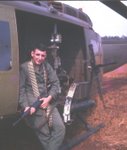
We flew plenty of resupply in the Kontum – Dac To areas and I think they were always “hot” due to the proximity to the Ho Chi Minh trail, Cambodia and Laos. Flying from Kontum to Dac To up highway 14 put you in a vulnerable position because the highway was at the bottom of a valley between two mountain ranges. You could look to the right and left and see nothing but steep high ground which frequently hid 51 caliber machine gun positions. We took a lot of small arms fire in this valley and you gained an uncomfortable sense of the concentration of the enemy force that was there.
My first exposure to the aftermath of battle was during resupply of a company size unit on hill 875 close to Dac To. The unit had been assaulted during the night by a very large enemy force and a fierce fire fight ensued. After loading up ammo and medical supplies in Kontum we flew back to Dac To. Hill 875 was northwest of Dak To and after finding it on our tactical map we had no trouble locating it and called the unit telling them we would be working for them for the day and were inbound with a load of C’s and meds. Nothing could have prepared us for what we found. Hill 875 and the surrounding area were almost totally barren of trees and vegetation. We identified the LZ by the smoke grenade ignited, called the color and made our approach from about 500 feet. All the way from the base of the hill to the perimeter concertina wire there were literally hundreds of green colored “lumps”. As we got lower to the helipad we identified the “lumps” as dead NVA troops. There was so many that in some areas close to the perimeter wire they were two and three deep stacked on one another. AK-47 rifles, ammunition, grenades, backpacks and pith helmets littered the ground as well. We were told later that this had been a regimental size “human wave assault”. To defend the position, the artillery pieces had been depressed to aim straight down the hill, loaded with what was called “beehive” rounds and fired at the advancing enemy. This round is loaded with 8,000 8-grain steel flechettes and was strictly used as perimeter defense ordinance. This ammunition was fired by the 105 howitzers. The company also defended itself with their M-16’s, M-79 grenade launchers, shotguns, pistols hand grenades, hand to hand fighting and bayonets. On the opposite side of the resupply pad were row upon row of the dark green rubberized body bags awaiting pickup for their final trip home. There is no need to get any more graphic about this horrible sight but it had a profound effect on all of us. We flew mostly in silence as we made our way back and forth from Dak To and Kontum delivering ammo, meds and C’s. Other Huey’s flew “dust off” at the same time, first removing the injured and then those that had perished. We were released in the evening and silently hoped we would never have to witness anything like this again. This happened 39 years ago and will haunt me forever as as one of my worst experiences of the war.



1 comment:
Very interesting, I will have to show your blog to Willie. He was in Vietnam 1967 in the Army. He was on PT Boats in Cam Rahn Bay(not sure if I spelled that right).
You should get on with that book.
Post a Comment